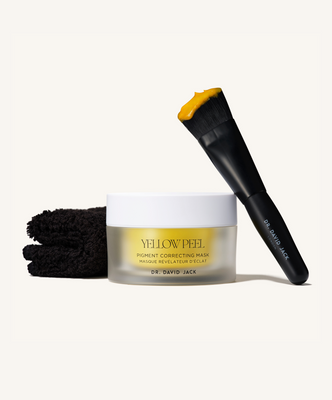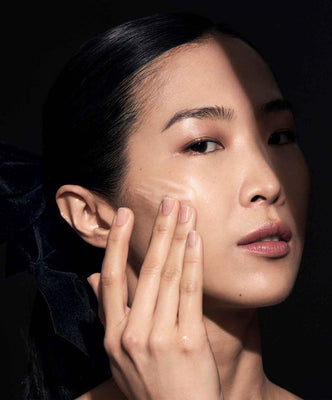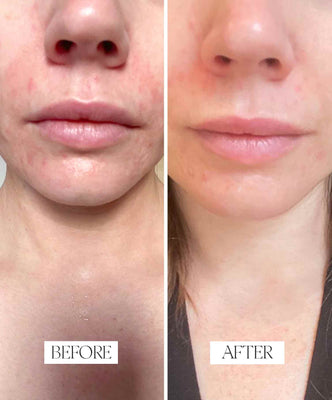· FACE FACTs ·
The Best Skincare Ingredients for Pigmentation Issues
Pigmentation issues, such as dark spots, melasma, post-inflammatory hyperpigmentation (PIH) and age spots, are some of the most common skin concerns we see in clinic. These conditions affect people across all skin types and can result from various factors, including sun exposure, hormonal changes, acne and following inflammation (post treatment or as a result of inflammatory skin conditions such as acne). Fortunately, there are a number of skincare ingredients that have proven particularly effective at reducing the appearance of hyperpigmentation and promoting a more even skin tone. In this detailed guide, I will explore the different types of pigmentation, the best skincare ingredients to address them, as well as potential concerns and issues with some of these treatments.
What is Skin Pigmentation?
Before diving into the best ingredients for pigmentation, it’s important to understand what pigmentation is and why it occurs.
Pigmentation refers to the colouring of the skin, which is primarily influenced by melanin – a natural pigment protein produced by cells in the dermo-epidermal junction of the skin called melanocytes. Pigmentation issues arise when there is an excess or insufficient production of melanin, leading to unevenness of skin tone. Pigmentation issues can arise from either overproduction or underproduction of melanin by melanocytes.The most common pigmentation issues include:
• Hyperpigmentation: Dark spots or patches that develop due to an overproduction of melanin. Common examples are age spots, sunspots and post-inflammatory hyperpigmentation (PIH). Melasma is a form of hyperpigmentation related to hormonal changes
• Hypopigmentation: A condition where there is a loss of melanin, leading to lighter patches of skin. This can occur after skin trauma or inflammation (such as in vitiligo).
• Melasma: A form of pigmentation that is often triggered by hormonal changes, such as during pregnancy (also called the "mask of pregnancy") or from the use of birth control pills.
With a clearer understanding of pigmentation, let’s explore the skincare ingredients that are known to be most effective at addressing pigmentation issues.
The Best Skincare Ingredients for Pigmentation
Vitamin C (Ascorbic Acid)
Vitamin C, also known as ascorbic acid, is a potent antioxidant that not only helps brighten the skin but also plays a crucial role in reducing the appearance of dark spots and hyperpigmentation, as well as being involved in collagen production in the skin. Vitamin C works by inhibiting the enzyme tyrosinase, which is a ‘rate limiting step’ in the production of melanin by melanocyte cells. Additionally, its antioxidant properties help prevent skin damage from free radicals, which can exacerbate pigmentation.
How does vitamin C work in skincare?
• Reduces the production of melanin.
• Protects against UV-induced skin damage, which can worsen pigmentation.
• Promotes collagen production, leading to firmer, more even-toned skin.
Potential Issues with vitamin C in skincare
While vitamin C is highly effective, it can be unstable and may degrade when exposed to light or air, making it less effective if not stored properly. This is why you might find vitamin C in products that are contained within dark bottles or vacuum pump containers. Additionally, some formulations can be irritating for sensitive skin, particularly those containing L-ascorbic acid - the pure form of vitamin C rather than Vitamin C esters such as Sodium Ascorbyl Phosphate or Ascorbly palmitate.
Vitamin C in skincare is best for:
• Sunspots
• Post-inflammatory hyperpigmentation (PIH)
• Age spots
• Melasma
For more on how Vitamin C works, check out this article: The Science Behind Vitamin C for Skin.
Niacinamide (Vitamin B3)
Niacinamide is a versatile ingredient known for its ability to target a range of skin concerns, including pigmentation. This powerhouse ingredient works differently than other ingredients for hyperpigmentation. It’s key mechanism of action in relation to hyperpigmentation is by inhibiting melanin transfer from melanocytes to other cells near the skin’s surface. This effectively lightens dark spots by restricting the spread of melanin in the skin. Niacinamide also helps strengthen the skin’s barrier, improving overall skin health and hydration.
How does Niacinamide Work in skincare?
• Inhibits the transfer of melanin, leading to reduced pigmentation.
• Improves skin elasticity and texture.
• Reduces the appearance of fine lines and wrinkles.
• Calms inflammation, making it a great choice for those with sensitive skin.
Potential Issues with Niacinamide in skincare
Niacinamide is generally well-tolerated by most skin types, but it can cause irritation or redness when used in high concentrations or combined with other potent actives like retinol.
Niacinamide in Skincare is Best For:
• Hyperpigmentation
• Uneven skin tone
• Acne scarring
Learn more about niacinamide’s benefits here.
Retinoids
Retinoids, including retinol, retinaldehyde and tretinoin (retinoid acid), are vitamin A derivatives that promote skin cell turnover and encourage the production of new, healthier skin cells. They also function (similar to vitamin C) as tyrosinase inhibitors to regulate melanin production. By both mechanisms, retinoids help to fade hyperpigmentation and improve overall skin texture.
How do retinoids work in skincare for pigmentation?
• Retinoids promote cell turnover, helping to slough off pigmented skin cells.
• Retinoids function as tyrosinase inhibitors to reduce excess production of melanin by melanocytes.
• They stimulate collagen production, which can help with skin rejuvenation.
• Retinoids improve skin texture and tone by speeding up the regeneration of skin cells.
Potential Issues with retinoids in Skincare:
Retinoids can cause dryness, irritation, and redness, especially in the beginning (a process known as retinization). It is therefore crucial to use retinoids gradually and always wear sunscreen, as they can increase skin sensitivity to UV radiation by reducing your natural protection from melanin.
Retinoids are best for:
• Sunspots
• Melasma
• Post-inflammatory hyperpigmentation (PIH)
• Fine lines and wrinkles
Alpha Arbutin
Alpha arbutin is a naturally occurring compound that helps brighten the skin and reduce pigmentation by inhibiting tyrosinase, the enzyme responsible for melanin production. It is considered a safer, less irritating alternative to hydroquinone and is often used in formulations targeting dark spots and uneven skin tone.
How Does Alpha-Arbutin work in Skincare?:
• Alpha-arbutin inhibits melanin production by , leading to lighter skin tone.
• Works gently, making it suitable for sensitive skin.
• Can be used in combination with other brightening ingredients like Vitamin C or niacinamide.
Potential Issues with Alpha-arbutin in skincare:
Alpha arbutin is generally well-tolerated, but individuals with highly sensitive skin may experience mild irritation. It is also less potent than hydroquinone, meaning it may take longer to see results.
Best For:
• Sunspots
• Age spots
• General skin brightening
Licorice Extract
Licorice extract contains glabridin, a compound known for its ability to inhibit tyrosinase activity and reduce the appearance of dark spots. It also has anti-inflammatory properties that can help calm irritation and redness in the skin, making it suitable for a wide range of skin types.
How Does Licorice Extract Work in Skincare?:
• Inhibits melanin production to fade dark spots.
• Reduces inflammation and redness, helping to soothe the skin.
• Improves skin brightness and tone.
Potential Issues with Licorice Extract:
Licorice extract is generally safe for most skin types, but it may cause irritation or sensitivity in some individuals, particularly when used in high concentrations.
What is Licorice Extract Best For?:
• Hyperpigmentation
• Redness and irritation
• Sensitive skin
Kojic Acid
Kojic acid is a popular pigmentation reducing ingredient in Asia and is widely found in Japanese and Korean skincare products. It is sourced as a by-product of the fermentation of certain foods, such as rice and soy, and is widely used for its ability to brighten the skin and treat pigmentation. It works by inhibiting the production of melanin, which helps to fade dark spots and even out skin tone.
How Does Kojic acid Work in Skincare?:
• Inhibits the production of melanin by blocking the enzyme tyrosinase, reducing the appearance of dark spots.
• Often used as an alternative to hydroquinone for lightening pigmentation.
Potential Issues with Kojic Acid in Skincare:
Kojic acid can cause irritation, particularly for those with sensitive skin. It is best to start with lower concentrations and gradually increase as tolerated. The use of Kojic acid has been limited in some countries at higher concentrations due to concerns about reducing the skin’s natural UV protection mechanisms.
Best For:
• Dark spots
• Sun damage
• Hyperpigmentation
Mandelic Acid
Mandelic acid is an alpha hydroxy acid (AHA) derived from bitter almonds. It has gained popularity in skincare due to its gentle exfoliating properties and effectiveness in treating hyperpigmentation, particularly for those with sensitive skin or darker skin tones. Mandelic acid is often considered a milder alternative to other AHAs like glycolic acid, while still delivering significant benefits for skin renewal and the treatment of pigmentation issues.
How It Works:
• Mandelic acid works by exfoliating the outer layers of the skin, helping to remove dead skin cells that may contribute to dullness and the appearance of dark spots
• Mandelic acid fades dark spots and uneven skin tone by encouraging cell turnover and inhibiting melanin production by inhibiting tyrosinase.
• Mandelic acid targets post-inflammatory hyperpigmentation (PIH) and sunspots, as well as general skin discolouration through it’s anti-inflammatory and antioxidant activity.
Potential Issues with Mandelic Acid:
While mandelic acid is gentler than other AHAs, overuse can still lead to irritation, redness, or peeling, particularly for individuals with very sensitive skin. It’s best to start with a lower concentration (around 5%) and gradually increase the usage frequency. Like all AHAs, mandelic acid increases the skin’s sensitivity to sunlight. Sunscreen is essential when using mandelic acid to prevent further pigmentation and protect the skin from UV-induced damage.
Mandelic Acid is Best For:
• Post-inflammatory hyperpigmentation (PIH): Especially helpful for acne scars and dark spots resulting from skin inflammation.
• Sunspots and age spots: Can lighten areas of pigmentation caused by UV exposure.
• Sensitive Skin: Since it has a larger molecular structure than other AHAs, mandelic acid penetrates the skin more slowly, which reduces the risk of irritation and makes it an excellent choice for those with sensitive or reactive skin.
Potential Issues with Some Pigmentation Ingredients
While many of the ingredients listed above can be highly effective in treating pigmentation, there are a few important things to keep in mind:
1. Skin Sensitivity: Ingredients like Vitamin C, retinoids, and kojic acid can be irritating, especially for those with sensitive skin. Always perform a patch test before using a new product and introduce active ingredients gradually into your routine.
2. Sun Sensitivity: Many brightening ingredients, including Vitamin C, retinoids, and hydroquinone, can make the skin more sensitive to sunlight, increasing the risk of sunburn and further pigmentation. Always wear sunscreen (SPF 50 or higher with broad spectrum protection) during the day to protect your skin.
3. Slow Results: Some ingredients, such as alpha arbutin and licorice extract, are milder than others like retinoids or hydroquinone. While they may take longer to show results, they tend to be gentler on the skin.
4. Combination Use: Some ingredients, such as retinoids and Vitamin C, can be harsh when used together. It’s often best to alternate between these ingredients or use them at different times of the day (e.g., Vitamin C in the morning and retinoids in the evening).
Conclusion
Pigmentation issues can be frustrating, but with the right skincare ingredients, significant improvements can be made. Remember, consistency is key, and while results may take time, a well-formulated skincare routine can help you achieve the even-toned, glowing skin you desire.
For more information on how to incorporate these ingredients into your routine, check out our full range of skincare products designed to target pigmentation concerns, including our award-winning Yellow Face Peel.
References
- Kulkarni, E. Tyrosinase inhibitors in skincare: what are they and why are they in popular demand? https://imperialbiosciencereview.wordpress.com/2021/05/21/tyrosinase-inhibitors-in-skincare-what-are-they-and-why-are-they-in-popular-demand/
- Markiewicz, E., Karaman-Jurukovska, N., Mammone, T., & Idowu, O. C. (2022). Post-inflammatory hyperpigmentation in dark skin: molecular mechanism and skincare implications. Clinical, cosmetic and investigational dermatology, 2555-2565. https://www.tandfonline.com/doi/full/10.2147/CCID.S385162
- Vashi, N. A., & Kundu, R. V. (2013). Facial hyperpigmentation: causes and treatment. British Journal of Dermatology, 169(s3), 41-56. https://academic.oup.com/bjd/article-abstract/169/s3/41/6614759


















